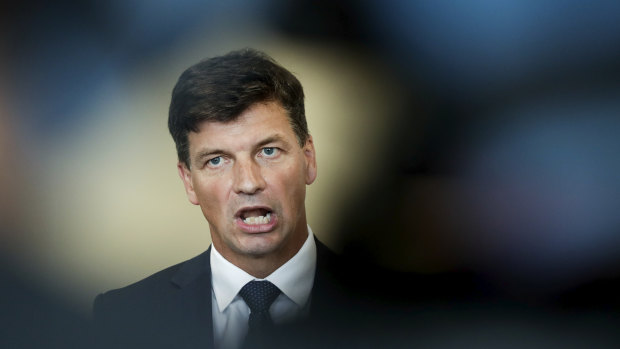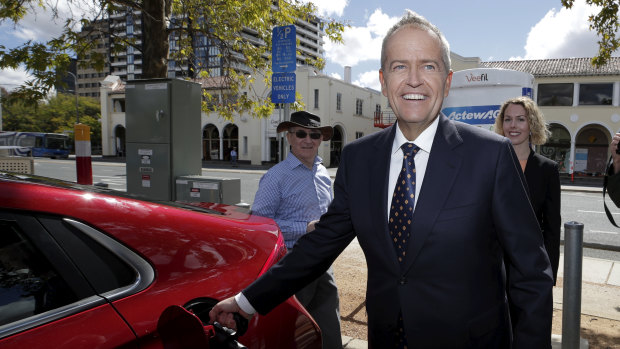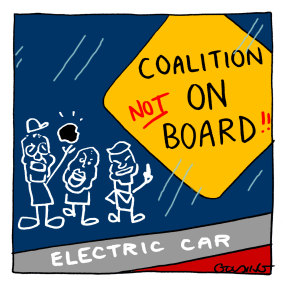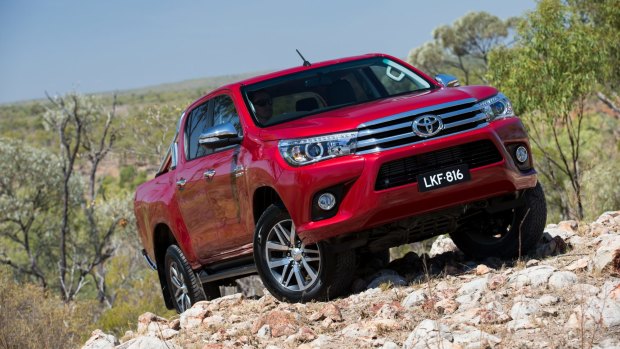This was published 6 years ago
Toyota scuppers claim Labor's electric vehicle policy would leave HiLux drivers stranded
Official analysis by the Department of the Environment and Energy has suggested electric vehicle uptake in Australia could be identical under the policies of both Labor and the Coalition.
Energy Minister Angus Taylor, however, insists Labor’s strategy is unsound despite the government's policy potentially achieving the same result.

Energy Minister Angus Taylor says the government's electric vehicle strategy is not comparable to Labor's, despite both policies potentially leading to the same uptake of the technology.Credit: Alex Ellinghausen
The government's claim that drivers of Australia's most popular car, the Toyota HiLux, would be left stranded under Labor has also been undermined after the company confirmed it was on track to offer an electrified version of all its models within six years.
The government this week ramped up its attacks on Labor's electric vehicle strategy ahead of the federal election, claiming it would force Australians out of the "cars they love" into smaller, more expensive vehicles to cut carbon emissions.
The Department of the Environment and Energy has estimated that the government's electric vehicle strategy, announced as part of its climate solutions package, would cut greenhouse gas emissions by 10 megatons by 2030.
The department says the figure was based on a federally funded report by consultancy Energeia that suggests electric vehicles could comprise between 25 and 50 per cent of new car sales by 2030. It says this would occur if action at all levels of government is coordinated through a national strategy – an approach adopted by the government.
The upper end of that projection, 50 per cent, is identical to Labor's target.
Energy Minister Angus Taylor on Tuesday did not dispute the department's analysis but insisted "our policy is not comparable to Labor's".
"Our national electric vehicle strategy may make it easier for Australians to choose an EV but we don't have a target, and we won't impose a harsh new emissions standard or a tax on new cars to drive uptake," he said.
"On the other hand, Labor has set a target, and are proposing serious interventions - including harsh emissions vehicle standards - in order to get there."
Labor would seek to encourage electric vehicle through new vehicle emissions standards of 105 grams of carbon dioxide per kilometre.

Opposition Leader Bill Shorten at an electric vehicle charging station in Canberra.Credit: Alex Ellinghausen
The Coalition's electric vehicle strategy also says it is "improving Australia's fuel quality" and it has previously proposed introducing the same emissions standard by 2025.

Illustration: Matt GoldingCredit:
However a ministerial forum convened by the government in 2015 to examine the issue stalled, and the Coalition now opposes Labor's vehicle emissions plan.
Mr Taylor said on Tuesday that vehicles such as the Toyota Hilux "breach these standards by a significant amount" and Labor was "taking choice away from consumers" about which cars they could drive.
Senator Michaelia Cash doubled down on the claim, tweeting that "Labor need[s] to explain to Australia's tradies why they want to ban their favourite utes".
Toyota aims to sell 5.5 million electric vehicles annually by 2030, and offer an electrified version of all its models by 2025. In a statement, Toyota Australia confirmed the company was on track to achieving those goals.

Toyota says it aims to offer an electric version of all its models by 2025, including the HiLux, pictured.
"Toyota has a global ambition of zero CO2 emissions from sites and vehicles by 2050 and Toyota Australia is part of that mission," it said, adding that significant infrastructure investment was needed before mass electric vehicle uptake was achieved.
The NRMA, Australia's largest motoring body, has disputed the government's claims that Labor's policy would take away consumer choice, saying the target applies only to half the vehicles sold, it would not be met for 11 years, and that manufacturers are developing or already sell electric versions of large vehicles.